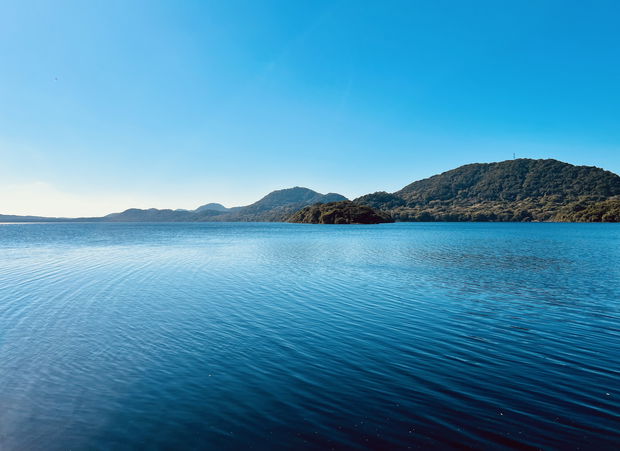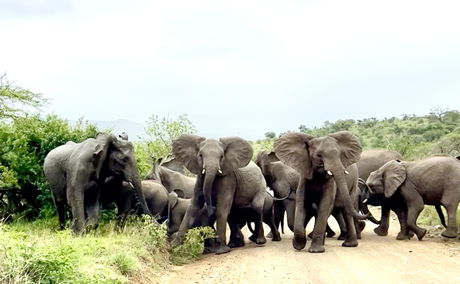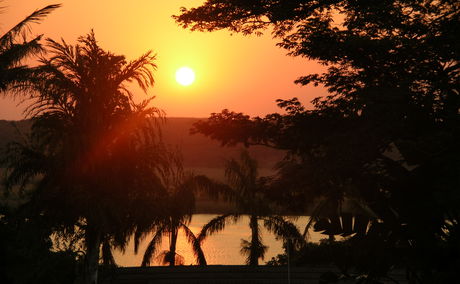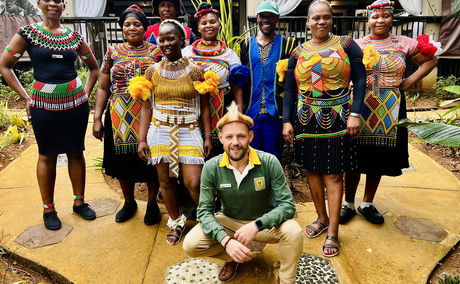There are few moments in life that remind us of nature’s quiet wisdom and unspoken harmony, moments that stop us in our tracks and leave us humbled. One such moment unfolded recently on the iMfolozi side of the Hluhluwe–iMfolozi Game Reserve, when a herd of around twenty five female elephants and their young crossed the dusty road before us. Engines idled. Conversations hushed. And in that stillness, we watched one of nature’s...
From Beach to Bush: The UNESCO Magic of St Lucia & iSimangaliso Wetland Park

There are places in the world where nature seems to follow ordinary patterns, and others where it breaks them entirely. St Lucia, a small, coastal town wrapped in the embrace of the iSimangaliso Wetland Park belongs unmistakably to the latter. This is a landscape where ecosystems blend in improbable ways, where wildlife moves confidently between human spaces, and where the natural world still feels vast, unfiltered and astonishing. It is little wonder that in 1999 UNESCO declared the region a World Heritage Site, calling it a place “where the miracle of nature begins.”
But to truly understand the significance of this area, one must journey back to the beginning, long before boards were erected, boundaries drawn, or conservation policies written.
Shaped by Water, Wind and Time
The story of iSimangaliso is ancient. Over the course of roughly 25,000 years, shifting sea levels sculpted Africa’s highest vegetated dune systems, some towering more than 180 metres above the coastline. These dunes, stretching some 220 kilometres, cradle freshwater lakes, hidden forests, marshlands and an extraordinary estuarine system that has always been the heartbeat of this landscape.
The St Lucia Estuary itself, one of the largest in Africa, is a shimmering, living mosaic shaped by the interplay of tides and seasons. Freshwater pushes down from inland catchments, saltwater drifts in from the Indian Ocean, and life thrives in the tension between the two. Mangrove forests spread their roots into the shallows, providing nurseries for countless fish species. Hippos wallow in deep channels while crocodiles warm themselves on sandy banks. Overhead, African fish eagles patrol the skies, their calls echoing across the water.
This region evolved as a rare natural experiment, a place where ocean, forest, wetland and savanna coexist within arm’s reach of one another.
Footprints and Traditions Through Time
Human history in the area stretches back many centuries. Archaeological evidence reveals that early Iron Age communities settled along the wetlands, drawn by its abundant resources. Later, Zulu clans lived in harmony with the estuary and surrounding forests, relying on fishing, hunting, gathering and the deep spiritual presence of the landscape. The word iSimangaliso itself, meaning “miracle” in isiZulu, reflects how profoundly the environment impressed those who lived closest to it.
Early colonial explorers recorded stories of “unfathomable wetlands” and unusual creatures moving in and out of shimmering waterways. Yet by the mid-20th century, this wilderness — so rich in life — was under serious threat. Mining exploration, overhunting, land pressure and environmental neglect placed immense strain on its fragile ecosystems. It became clear that without decisive action, the uniqueness of this environment could easily be lost.
Then, in the late 1990s, everything changed.
The Turning Point to World Heritage Status
In 1999, after significant environmental research and community consultation, UNESCO recognised the iSimangaliso Wetland Park as South Africa’s first World Heritage Site. This was not a symbolic gesture, it was a global acknowledgment of the region’s incomparable ecological value.
The recognition stemmed from the remarkable convergence of natural features found here. Few places on Earth hold such a concentration of ecosystems in such close proximity: warm Indian Ocean waters and vibrant coral reefs, Africa’s largest estuarine lake system, expansive wetlands, sweeping savannas and ancient coastal dune forests. More than 6,500 plant and animal species inhabit the region, including over 500 bird species, both loggerhead and leatherback turtles, abundant hippo and crocodile populations, and numerous rare or threatened animals.
UNESCO described iSimangaliso as exceptional precisely because of the way its major ecosystems interact, each one influencing and nourishing the next. It is this interplay that gives the region its character, its resilience, and its extraordinary biodiversity.
St Lucia: A Town Living at Nature’s Doorstep
Today, St Lucia stands as a charming coastal village, yet the wilderness remains woven into its identity. Wildlife still roams confidently through the edges of town. Hippos graze casually along the towns grassy verges at night, bushbuck drift through gardens, warthogs trot about, hornbills and turacos flash between branches, and the call of a fish eagle often carries through the morning air. For visitors, the proximity of nature is not a curated moment, it is simply part of everyday life.
What makes St Lucia so captivating is how effortlessly travellers can move between environments. Within minutes, one can walk through shaded coastal forest, drive into open savanna, explore the banks of the estuary, snorkel over coral reefs at Cape Vidal, or stand atop ancient dunes overlooking the untouched sweep of the Indian Ocean. It is a rare corner of the planet where a “beach-to-bush” experience does not require long journeys or crowded viewing points.
Why This Place Matters Now — More Than Ever
In a world where natural spaces are rapidly shrinking, the iSimangaliso Wetland Park stands as one of the last large, intact wetland systems. Its protection is vital for reasons far beyond its beauty.
The wetlands act as natural water filters and flood regulators, storing carbon at exceptional rates and helping stabilise regional climates. The estuary and coastline provide critical sanctuary to endangered species, including sea turtles that return every summer to lay their eggs on the same beaches their ancestors used for millennia. Migratory birds depend on the wetlands during complex seasonal journeys that span continents. Inland, savannas offer refuge to rhino, elephant and numerous species whose survival depends on the preservation of vast, functioning ecosystems.
This landscape also safeguards human heritage. Communities who live alongside the park continue to connect with traditions, stories and livelihoods shaped by the wetlands. The cultural and ecological value of iSimangaliso is inseparable — both must endure for the region to remain whole.
Most importantly, this protected area ensures that the wonders of St Lucia will still be here for generations yet to come. Children born decades from now deserve the chance to see a turtle nest, listen to hippos calling at night, or stand in awe atop a dune system older than many human civilisations.
Experiencing the Miracle
Visitors soon discover that experiencing iSimangaliso is not simply about ticking off sightings, it is about immersion. Boat cruises drift past pods of hippos and prehistoric crocodiles, offering a front-row seat to the life of the estuary. Forest walks reveal samango monkeys leaping between branches and bright forest birds darting through shafts of light. Snorkelling at Cape Vidal uncovers colourful underwater worlds, while game drives open onto savannas dotted with antelope, rhino and the occasional wandering elephant.
And on warm summer nights, long after the sun has slipped below the horizon, one of nature’s most ancient rituals unfolds on the sand. A female turtle hauls herself from the surf, crosses the moonlit beach and begins to dig her nest, a ritual older than humanity itself. It is in these moments that the emotional heart of iSimangaliso reveals itself, quiet and humbling.
Where Worlds Meet and Miracles Begin
From its ancient dune systems to its shimmering estuary, from the Indian Ocean to the inland savannas, St Lucia and the wider iSimangaliso Wetland Park offer one of the most remarkable natural landscapes on Earth. It is a place sculpted by time, guarded by history, and fiercely protected for generations to come.
And for those who journey here, the experience becomes even more meaningful when paired with a place to stay that mirrors the tranquillity of the landscape itself. At Lidiko Lodge, guests can retreat into comfort after days spent exploring the park’s wonders. The lodge’s serene gardens — lush, shaded and alive with birdlife — create a sanctuary where nature is never out of sight or earshot. Spacious, beautifully appointed rooms offer a peaceful rest at the end of each adventure, while our warm, attentive service ensures that travellers feel not just welcomed, but genuinely cared for.
Each morning begins with our celebrated breakfasts, enjoyed in a setting so calm that the outside world feels very far away. Yet from our gate, the nearest entrance into iSimangaliso Wetland Park lies just 2.5 kilometres down the road — making Lidiko Lodge one of the most convenient and inviting bases from which to explore this extraordinary region. Surrounded by nature, enveloped in comfort and perfectly positioned between forest, estuary and ocean, the lodge offers a front-row seat to everything that makes St Lucia such a rare and magical destination.
Here, at the meeting point of beach and bush, wilderness and comfort, the miracle of iSimangaliso unfolds — both within the park and in the quiet, restorative spaces where travellers choose to rest.
Further Reading
There’s something almost otherworldly about arriving in St Lucia. The coastal air carries a mix of salt and forest scent, the streets are shaded by dense tree canopies, and now and then, a hippo might amble lazily down the main road at night as if to remind everyone that this is still their turf. It’s a village where the wild and the relaxed coexist and where international travellers are increasingly finding the...
When guests arrive at Lidiko Lodge, many pause to take in the moment — the scent of the tropical gardens, the rustle of palm leaves, and the calls of birds drifting through the coastal air. It is often described as the instant when the journey melts away and a feeling of belonging takes its place. For years, this sense of arrival has been at the heart of what makes a stay at...





Share This Post